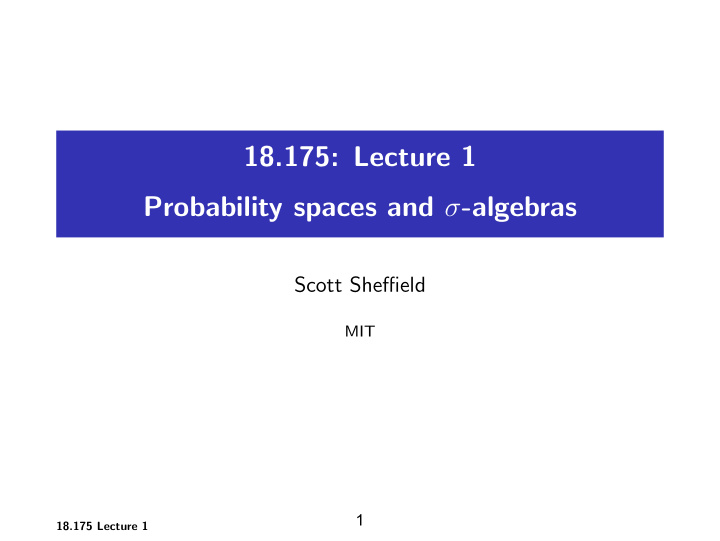



18.175: Lecture 1 Probability spaces and σ -algebras Scott Sheffield MIT 1 18.175 Lecture 1
Outline Probability spaces and σ -algebras Distributions on R 2 18.175 Lecture 1
Outline Probability spaces and σ -algebras Distributions on R 3 18.175 Lecture 1
Probability space notation � Probability space is triple (Ω , F , P ) where Ω is sample space, F is set of events (the σ -algebra) and P : F → [0 , 1] is the probability function. � σ -algebra is collection of subsets closed under complementation and countable unions. Call (Ω , F ) a measure space. � Measure is function µ : F → R satisfying µ ( A ) ≥ µ ( ∅ ) = 0 for all A ∈ F and countable additivity: µ ( ∪ i A i ) = f i µ ( A i ) for disjoint A i . � Measure µ is probability measure if µ (Ω) = 1. 4 18.175 Lecture 1
Basic consequences of definitions monotonicity : A ⊂ B implies µ ( A ) ≤ µ ( B ) f ∞ � � subadditivity : A ⊂ ∪ ∞ implies µ ( A ) ≤ m =1 µ ( A m ). m =1 A m � � continuity from below: measures of sets A i in increasing � � sequence converge to measure of limit ∪ i A i continuity from above: measures of sets A i in decreasing � � sequence converge to measure of intersection ∩ i A i 5 18.175 Lecture 1
Why can’t σ -algebra be all subsets of Ω? Uniform probability measure on [0 , 1) should satisfy � translation invariance: If B and a horizontal translation of B are both subsets [0 , 1), their probabilities should be equal. Consider wrap-around translations τ r ( x ) = ( x + r ) mod 1. � � By translation invariance, τ r ( B ) has same probability as B . � � Call x , y “equivalent modulo rationals” if x − y is rational � � (e.g., x = π − 3 and y = π − 9 / 4). An equivalence class is the set of points in [0 , 1) equivalent to some given point. There are uncountably many of these classes. � � Let A ⊂ [0 , 1) contain one point from each class. For each � � x ∈ [0 , 1), there is one a ∈ A such that r = x − a is rational. Then each x in [0 , 1) lies in τ r ( A ) for one rational r ∈ [0 , 1). � � Thus [0 , 1) = ∪ τ r ( A ) as r ranges over rationals in [0 , 1). � � If P ( A ) = 0, then P ( S ) = f P ( τ r ( A )) = 0. If P ( A ) > 0 then � � r P ( S ) = f P ( τ r ( A )) = ∞ . Contradicts P ( S ) = 1 axiom. r 6 18.175 Lecture 1
Three ways to get around this 1. Re-examine axioms of mathematics: the very existence � of a set A with one element from each equivalence class is consequence of so-called axiom of choice . Removing that axiom makes paradox goes away, since one can just suppose (pretend?) these kinds of sets don’t exist. 2. Re-examine axioms of probability: Replace countable � � additivity with finite additivity ? (Look up Banach-Tarski.) 3. Keep the axiom of choice and countable additivity but � � don’t define probabilities of all sets: Restrict attention to some σ -algebra of measurable sets. Most mainstream probability and analysis takes the third � � approach. But good to be aware of alternatives (e.g., axiom of determinacy which implies that all sets are Lebesgue measurable). 7 18.175 Lecture 1
Borel σ -algebra � The Borel σ -alg ebra B is the smallest σ -algebra containing all open intervals . � Say that B is “g enerated” by the collection of open intervals. � � Why does this n otion make sense? If F i are σ -fields (for i in possibly uncount able index set I ) does this imply that ∩ i ∈ I F i is a σ -field? 8 18.175 Lecture 1
Outline Probability spaces and σ -algebras Distributions on R 9 18.175 Lecture 1
Outline Probability spaces and σ -algebras Distributions on R 10 18.175 Lecture 1
MIT OpenCourseWare http://ocw.mit.edu 18.175 Theory of Probability Spring 2014 For information about citing these materials or our Terms of Use, visit: http://ocw.mit.edu/terms.
MIT OpenCourseWare http://ocw.mit.edu 18.175 Theory of Probability Spring 2014 For information about citing these materials or our Terms of Use, visit: http://ocw.mit.edu/terms .
Recommend
More recommend